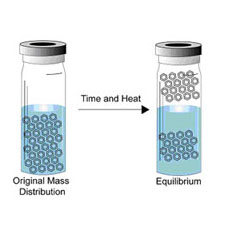Extracting VOCs with Precision
Purging a sample to extract analytes is a complex gas extraction process. Many factors affect the efficiency of this extraction. The amount of each compound purged is proportional to both its vapor pressure and its solubility in the sample. Both of these are, in turn, are affected by the sample temperature.

In the case of a sample sealed in a closed vial, the sample matrix is a vapor space usually referred to as the “headspace.” If you allow the sample sufficient time, volatile organic compounds in the sample will migrate into the vapor space. After a certain period of time an equilibrium will be established; the concentration of the compounds in each phase will be stabilized.
At this point, a portion of the headspace can be removed and injected
into the gas chromatographer (GC) for analysis. This technique is known as “equilibrium analysis” or “static
headspace analysis.” The amount of material in the vapor phase will be
proportional to the partial pressure of the component.
In understanding the behavior of volatile compounds in a sample, it's important to consider the relationship between vapor pressures and compound concentrations. This relationship can be expressed through the following equation, which relates the total vapor pressure of a system to the partial pressures and mole fractions of its components:
PT = P1 + P2 + P3 + ... + Pn = X1P1o + X2P2o + X3P3o + ... + XnPno
where:
PT = total vapor pressure of system
P1, etc. = partial pressure of each compound
P1o, etc. = vapor pressures of the pure compounds
x1, etc. = mole fractions of each compound
In purging a sample, the system is no longer at equilibrium because volatile compounds in the vapor phase are constantly being removed. There is no migration of components from the vapor to liquid phase. This means that the partial pressure of any individual component above the sample at any time is essentially zero.
This encourages even greater migration of the volatiles into the vapor phase more efficiently than equilibrium. This is true even if the volumes of headspace gas are the same. Purging a sample for 10 minutes with helium (at a flow rate of 50ml/min.) results in more efficient extraction of volatiles than equilibrium, using 500ml headspace.
This purging technique is called “dynamic headspace analysis." For aqueous matrices, the increase in efficiency can be upwards of 100-fold, using dynamic versus static headspace analysis.
Extraction efficiency increases with an increase in sweep volume. Sweep volume is the amount of purge gas used to purge and trap the analytes. Sweep volume is a function of sweep time and flow rate.
Since the analytes are being trapped on an adsorbent bed, there are limitations to the sweep times and flow rates that can be used. These limitations are determined by the compounds of interest in the sample and the packing material used in the trap.
